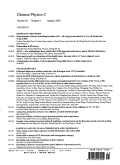- 钛学术文献服务平台 \
- 学术期刊 \
- 基础科学期刊 \
- 物理学期刊 \
- 中国物理C(英文版)期刊 \
Weak decays of doubly heavy baryons: Bcc →BD(*)
Weak decays of doubly heavy baryons: Bcc →BD(*)
基本信息来源于合作网站,原文需代理用户跳转至来源网站获取
摘要:
The discovery of[(I)]++cc has inspired new interest in studying doubly heavy baryons.In this study,the weak decays of a doubly charmed baryon Bcc to a light baryon B and a charm meson D(*) (either a pseudoscalar or a vector one) are calculated.Following our previous work,we calculate the short distance contributions under the factorization hypothesis,whereas the long distance contributions are modeled as the final state interactions,which are calculated with the one particle exchange model.We find that the Bcc → BD* decays' branching ratios are obviously larger,as they receive contributions of more polarization states.Among the decays that we investigate,the following have the largest branching fractions:B'R([(I)]++cc → ∑+D*+) ∈[0.46%,3.33%]estimated with τ[(I)]++cc =256 fs;BR([(I)]++cc → ΛD*+) ∈[0.38%,2.63%]and BR([(I)]++cc → ∑0D*+) ∈[0.45%,3.16%]with τ[(I)]++cc=45 fs;and BR(Ω+cc →[(I)]0D*+) ∈[0.27%,1.03%],BR(Ω+cc →[(I)]0D+) ∈[0.07%,0.44%],and BR(Ω+cc → ∑0D*+) ∈[0.06%,0.45%]with τΩ+cc =75 fs.By comparing the decay widths of pure color commensurate channels with those of pure bow-tie ones,we find that the bow-tie mechanism plays an important role in charm decays.

推荐文章
Bioavailability of heavy metals in soil of the Tieguanyin tea garden, southeastern China
Geo-accumulation index
Tieguanyin tea garden
Heavy metals
Bioavailability
Dilute nitric acid extraction
Southeastern China
Geochemical distribution, fractionation, and sources of heavy metals in dammed-river sediments: the
Heavy metals
Fractionation
210Pb dating
Smelting and mining activities
Sediment cores
The Longjiang River
Effects of organic mineral fertiliser on heavy metal migration and potential carbon sink in soils in
Karst
Soil pollution
Cd
Organic mineral fertilisers
Carbon sink
Distribution and ecological risks of heavy metals in Lake Hussain Sagar, India
Trace metals
Lake sediment
Geochemistry
Speciation
Industrial effluents
Idol immersion
内容分析
关键词云
关键词热度
相关文献总数
(/次)
(/年)
文献信息
| 篇名 | Weak decays of doubly heavy baryons: Bcc →BD(*) | ||
| 来源期刊 | 中国物理C(英文版) | 学科 | |
| 关键词 | |||
| 年,卷(期) | 2021,(4) | 所属期刊栏目 | PARTICLES AND FIELDS |
| 研究方向 | 页码范围 | 130-152 | |
| 页数 | 23页 | 分类号 | |
| 字数 | 语种 | 英文 | |
| DOI | 10.1088/1674-1137/abe0bc | ||
五维指标
引文网络
引文网络
二级参考文献 (0)
共引文献 (0)
参考文献 (3)
节点文献
引证文献 (0)
同被引文献 (0)
二级引证文献 (0)
1974(1)
- 参考文献(1)
- 二级参考文献(0)
1986(1)
- 参考文献(1)
- 二级参考文献(0)
2005(1)
- 参考文献(1)
- 二级参考文献(0)
2021(0)
- 参考文献(0)
- 二级参考文献(0)
- 引证文献(0)
- 二级引证文献(0)
引文网络交叉学科
相关学者/机构
期刊影响力
中国物理C(英文版)
主办单位:
中国物理学会
中国科学院高能物理研究所
中国科学院近代物理研究所
出版周期:
月刊
ISSN:
1674-1137
CN:
11-5641/O4
开本:
出版地:
北京市玉泉路19号(乙)中国科学院高能物理研究所内 北京918信箱
邮发代号:
创刊时间:
语种:
eng
出版文献量(篇)
3629
总下载数(次)
0
总被引数(次)
2764
期刊文献
相关文献
推荐文献
- 期刊分类
- 期刊(年)
- 期刊(期)
- 期刊推荐
力学
化学
地球物理学
地质学
基础科学综合
大学学报
天文学
天文学、地球科学
数学
气象学
海洋学
物理学
生物学
生物科学
自然地理学和测绘学
自然科学总论
自然科学理论与方法
资源科学
非线性科学与系统科学
中国物理C(英文版)2022
中国物理C(英文版)2021
中国物理C(英文版)2020
中国物理C(英文版)2019
中国物理C(英文版)2018
中国物理C(英文版)2017
中国物理C(英文版)2016
中国物理C(英文版)2015
中国物理C(英文版)2014
中国物理C(英文版)2013
中国物理C(英文版)2012
中国物理C(英文版)2011
中国物理C(英文版)2010
中国物理C(英文版)2009
中国物理C(英文版)2008
中国物理C(英文版)2021年第9期
中国物理C(英文版)2021年第8期
中国物理C(英文版)2021年第7期
中国物理C(英文版)2021年第6期
中国物理C(英文版)2021年第5期
中国物理C(英文版)2021年第4期
中国物理C(英文版)2021年第3期
中国物理C(英文版)2021年第2期
中国物理C(英文版)2021年第12期
中国物理C(英文版)2021年第1期

 免费查重
免费查重










